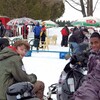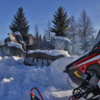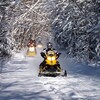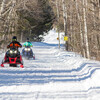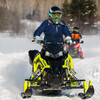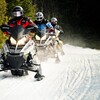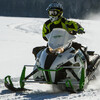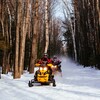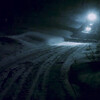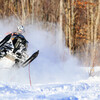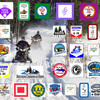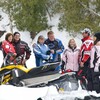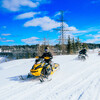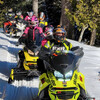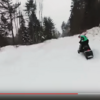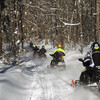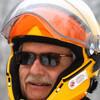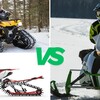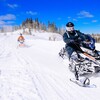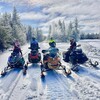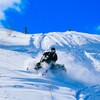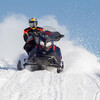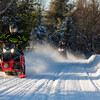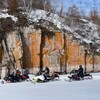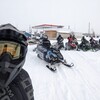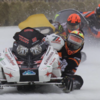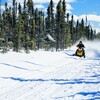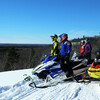
A Beginner's Guide to Snowmobile Lingo
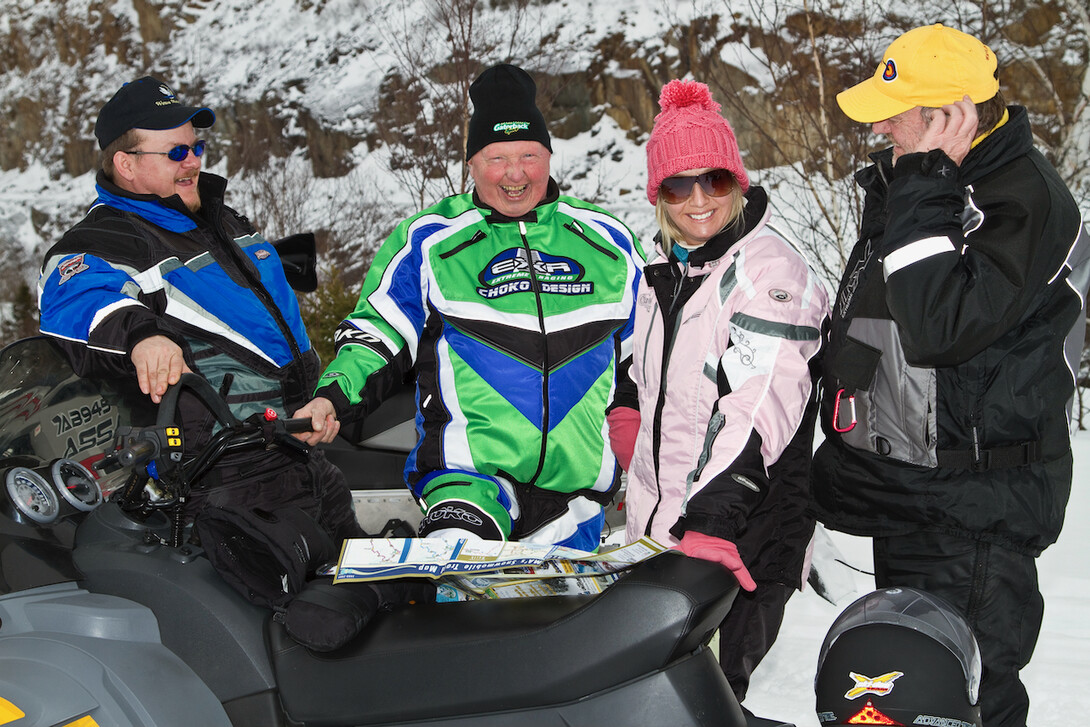
Every activity has its own lingo. Jargon and phrases developed over the years that participants use to communicate with each other, like their own secret code. Lawyers have it. So does the medical profession. But their vernacular may be hard to understand or meaningless to anyone not in the know.
Snowmobiling is no different. We’ve got colloquial words and favourite sayings, some of which are widely used, while others are region-specific. Here’s some of the sledding language I’ve heard while trail riding throughout Ontario.
This glossary of trail riding terms is a work in progress as I may have overlooked some obvious additions. It includes some descriptive slang you may have heard or experienced, along with some of my own editorial comments and a few tongue-in-cheek remarks I couldn’t resist. But I’ve left out the many four-letter expletives uttered by riders when their sled runs out of gas or breaks down in the middle of nowhere. Also, if you’re looking for more about the formal language associated exclusively with organized snowmobiling in Ontario, it can be found in my post 31 Ways To Get In The Know About Snowmobile Trail Riding in Ontario. Let’s get started…
Trail Terminology
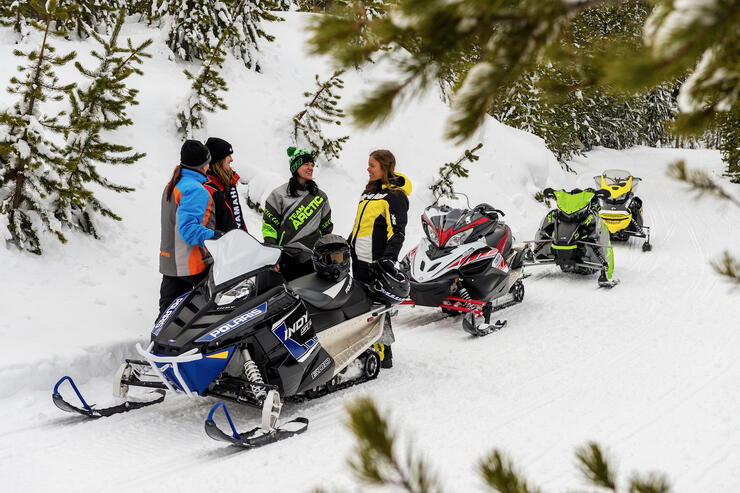
OFSC Prescribed Snowmobile Trail: A recreational, winter-only snowmobile trail that is part of the OFSC trail system, where by provincial law, entry to use requires an Ontario Snowmobile Trail Permit.
TOP Trail: Acronym for Trans Ontario Provincial Trail, the primary, multi-district touring routes operated by the OFSC as the backbone of its provincial trail system.
OFSC Interactive Trail Guide (ITG): The ITG is the sole authorized source for snowmobile trail availability information in Ontario. Snowmobilers are accustomed to viewing the ITG for accurate trail updates, route planning and safety information.
Trail Status: Refers to a trail being Available to ride (Green), having Limit Availability (Yellow) or being Unavailable (Red) to ride as shown on the OFSC Interactive Trail Guide (ITG).
Snow Tours: A collective name referring to all OFSC-promoted loops shown on the OFSC Website and Interactive Trail Guide.
POI: Often marked on trail maps, a point of interest may be a waterfall, dam, ice cave, lookout, deer yard, abandoned railway station or other scenic attraction worth stopping at.
Warm-up Shack/Shelter/Rest Stop: A small building often placed by the local snowmobile club at an intersection or other location along an OFSC trail, usually with a wood stove to warm up and benches to sit. Often beside an outdoor porta potty.
Pit Stop: It’s time for a pit stop at a trail-accessible service when you need fuel, munchies, lunch, and most importantly restrooms.
Cookout: A trailside lunch with a fire for cooking and warmth, often a family activity or an organized fundraiser for a snowmobile club.
Poker Run: A fundraiser usually put on by a snowmobile club often with a trailside cookout, where participants collect poker cards at various checkpoints and best hand wins a jackpot.
Kilometre: For our American friends, remember that our trail distance is measured in kilometres (km), with 1 kilometre = 0.621371 of a mile – so guess what? On that OFSC trail you’re riding, you’ve only gone about two-thirds as far as you thought!
Groomer: A purpose-built machine that can cost $250,000 or more, used to pack and smooth snowmobile trails, usually comprised of an industrial tracked unit or a tractor pulling a large drag. Can also refer to a snowmobile pulling a smaller drag, often used on trails too narrow for industrial equipment or in early season to start packing swamps that aren’t ready to bear the full weight of a larger groomer and drag.
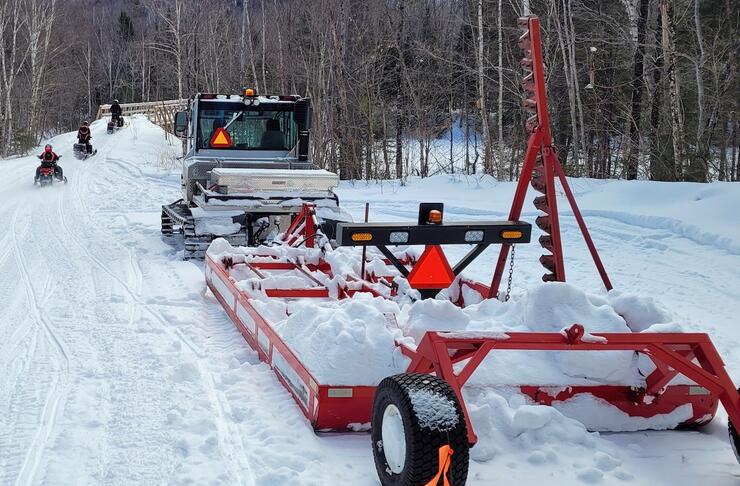
Drag: A highly specialized piece of equipment towed behind a groomer, usually with multiple hydraulic cutting blades and large packer pan.
Staked Trail: Stakes are red-coloured wooden pickets or plastic tubes usually placed on both sides of a designated trail by a snowmobile club to mark the approved route through private property like farm fields or sensitive areas. Always stay between the stakes.
Stake Line: A designated route for travel over ice, marked with stakes at regular intervals to show the way.
Portage: Usually an ungroomed section of trail between two lakes. See goat path…
Goat Path: A narrow, rough and often unmaintained trail that even a goat wouldn’t enjoy using.
Road Running: Riding along a plowed roadside, often to get from one part of an OFSC trail to its continuation farther along to bypass a section of private property where land use permission has been lost.
Follow Road To Trail: Wording on the sign posted where the OFSC trail meets a road, indicating that the trail continues along the plowed road, so road running is necessary, usually for a much longer distance than expected.
Direct Trail Access: Used to describe a lodging or service that is completely reachable by an OFSC trail without running any pavement – at least until you get to their parking lot!
Trail Accessible: Used to describe a lodging or service that may be near an OFSC trail, but does not have direct trail access, and so is only reachable by an unofficial pathway or laneway, by riding snowbanks, or by road running. May include riding bare pavement when the snow is ploughed or melts away!
Table Top: Describes a smooth-as-silk and often freshly groomed trail in front of you, as in “flat as a table top”.
Mogul: A hard bump frozen into the trail surface, typically caused by the hard accelerations and spinning tracks of previous riders. Your back won’t be happy to take a hard hit from a mogul!
Washboard: Describes a trail that sets your teeth chattering from a seemingly unending series of small, stutter bumps, where the surface resembles one of those old fashioned washboards. Also called “chatter bumps.”
Humped Out: Not to be confused with being tired after sex, this describes a trail surface that’s beyond washboarded, so badly and continuously moguled out that it’s goat-path rough to ride and jarring to both sled and bod.
Riding Jargon
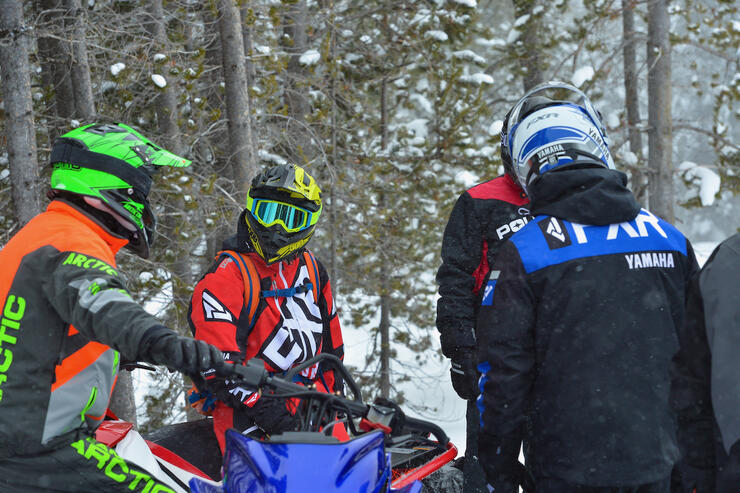
Braaap: Derived from the crack of noise emitted by a piped sled when the engine is revved, this is an insider’s codeword for snowmobiling, as in “let’s go for a braaap” or “go braaaping”, or just plain “braaaap”.
Sled Head: An avid person who lives and breathes snowmobiling – and dreams about it all summer long.
Snow Chaser: A rider who always goes where the snow is each winter, no matter what or how far away.
Weekend Warrior: Typically applied to a rider who lives in areas without snow or trails and/or works a weekday job, and so is only able to hit the snowmobile trails on weekends.
Saddlebagging/Saddlebag Tour: A multi-day ride staying at different lodgings each night, so carrying all belongings on your sled every day is necessary. Just be sure to fasten your saddlebags securely or you’ll be living in your snowmobile suit for the rest of the ride!
Stay ‘n’ Play Ride: A multi-day ride staying at the same lodging every night, while doing daily loops there and back. Perfect for family rides and couples’ tours – and for those who’ve already lost their saddlebags! Click here to learn more about saddlebag touring and stay ‘n’ play rides.
Destination Ride: Typically a day ride to a favorite lunch stop and back.
Blitz Ride: Not a state of impairment, but a quick weekend getaway ride that weekend warriors do to pack the most snowmobiling possible into a very tight time frame. Click here to learn more about Blitz Riding.
Trailering: Happens when any ride starts with loading your sleds on a trailer to drive to go snowmobiling at another destination, so hauling your sled to the dealer for service doesn’t count!
Ride Your Side: Phrase coined by an Ontario club volunteer to remind snowmobilers to always keep to the right side of the trail. Click here to learn more about Ride Your Side.
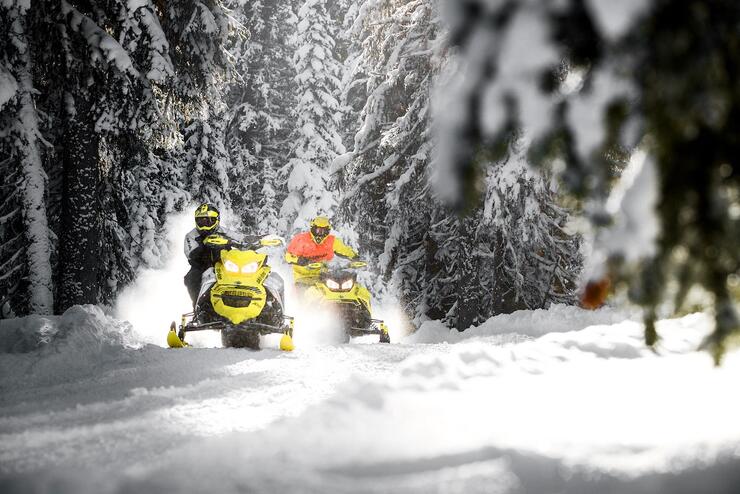
Taking Your Side of The Trail From The Middle: Derogatory expression used to describe a snowmobiler who’s riding the centre of the trail instead of riding their side, to the right of the trail.
Know Before You Go: Refers to always checking Trail Status on the ITG or local ice conditions prior to starting your ride.
Keep The Rubberside Down: A wise invocation to always ride with your track in contact with the trail surface.
Snow Magnet: That often deep white stuff along the edge of a groomed trail that can suddenly suck in your right ski, lead to an embarrassing sled burial beside the trail. Been there, done that!
In the Rhubarb: What it’s called when your sled goes off the trail into the bush. Sometimes caused by snow magnets, but most often by overestimating your own capabilities. Also referred to as “gone sight-seeing”.
Helmet Head: A weird hairstyle shared by snowmobilers who aren’t bald, caused by riding with hair mashed down under your lid – and why a ball cap is a must as soon as your helmet comes off!
Ate Lunch Twice: An expression derived from regurgitation that can occur when your sled hits too many moguls after eating. Usually happens right after lunch, which never tastes as good the second time around!
Out-Riding Your Headlights: Going fast enough at night that by the time anything on the trail ahead is illuminated by your headlights, there’s not have enough reaction time or stopping distance to safely avoid it.
Throttle Thumb: Strained thumb condition often caused by a stiff throttle, one that’s too wide for the operator’s hand, or simply riding way too much – as if there’s any such thing! Time for an adjustment or a finger throttle.
Racking Up The Klicks: Used to describe a long distance trail ride that puts many more kilometres on your odometer.
Hit The Trails/Go For A Rip: Popular expressions meaning to go trail riding with your buds.
Send It: The phrase “Just Gonna Send It” was coined by YouTube stunt rider Larry Enticer in reference to jumping over impossibly larger gaps with more attention to actions than consequences, and “Send It” is now being used by some riders.
Sled Speak
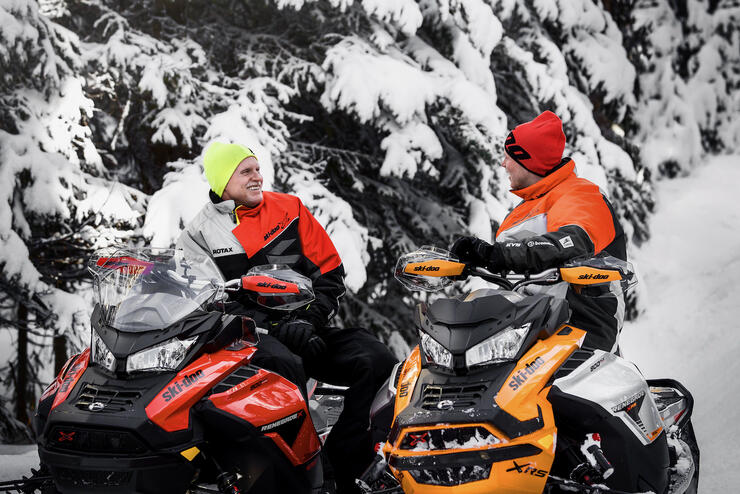
Snowmobile: Designed for winter travel and recreation on snow, it is also known as a “snow machine”, “ski-doo”, “toy”, “motorized snow vehicle” and sometimes, money pit. For some reason, it’s also often called a “sled”, although the definition of that word is: “a vehicle, typically on runners, for conveying goods or passengers over snow or ice”. So calling a snowmobile by that name is really a bit of a stretch!
OEM: Original Equipment Manufacturer. In the snowmobile world the term is typically used to collectively refer to Arctic Cat, BRP (Ski-Doo), Polaris & Yamaha.
Aftermarket: In snowmobiling, refers to non-OEM parts, accessories and clothing suppliers.
2-Up: Refers to riding double on one snowmobile with the seat configured for riding with a passenger behind the operator, either with an extra-long track & seat factory installed for 2 persons or with a removable passenger seat with a back rest. Be sure to re-adjust your rear suspension to accommodate the additional weight of the passenger, and click here for more riding double secrets.
To the Bar: No, not a trip to the local pub. It’s a reference to pressing the throttle all the way in so it's touching the handlebar. Also referred to as “pin it” or “give ‘er”. See track spinning…
Track Spinning: What happens when the throttle is depressed faster than the track gets enough traction to transfer the engine power into sled motion. Often occurs when your sled is stuck and giving it more throttle just causes the track to whirl around, digging the back end deeper into that snow you’re already stuck in. The sound of track spinning’s not what you want to hear on bare pavement!
Track Lock: Not an anti-theft device, but what happens to your track when you grab and hold the brake lever to the bar to stop instead of pumping it.
Barrel Roll: What can happen if you lock your track by jamming on the brake when trying to stop suddenly while going too fast.
Ski Lift: Can occur when the outside ski rises above the snow during hard cornering due to poorly adjusted suspension. Not to be confused with how you get to the top of a ski hill.
Bottoming Out: Occurs when the weight of riders and/or gear on your sled is too heavy for the rear suspension to support properly – like when you hit a really bad mogul!
Darting: What it’s called when your skis jerk slightly from side to side from previous ski tracks frozen into the surface of the trail. Can be caused by overly aggressive carbides or too much weight on the skis.
Running on Fumes/Running on Empty: What happens after your fuel warning light comes on and that old Jackson Browne tune starts playing over and over in your head.
Scratchers: Spring loaded or cable accessory usually attached to the rear underside on both sides of your sled’s frame that drag along the trail surface while riding hard-packed or icy trails to throw a spray of snow/ice into the track and help keep the heat exchanger cooler so your engine won’t overheat.
Weather-Related Lingo
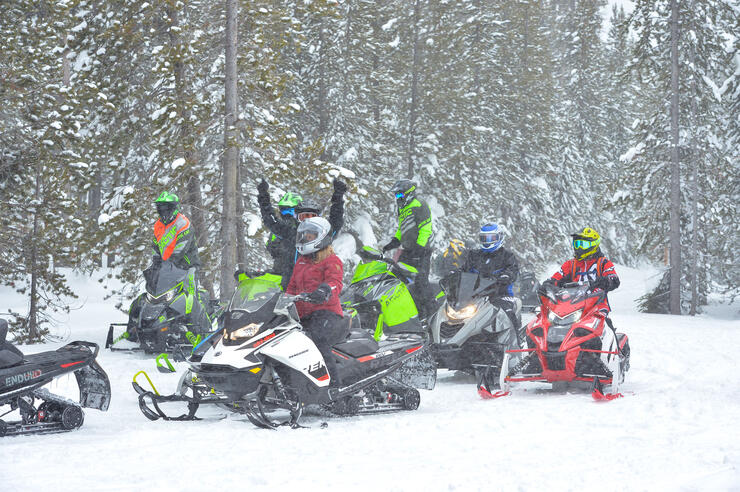
White Gold: A term I invented for snow referring to the economic impact of the white stuff.
Snow Dance: What snowmobilers do to get Old Man Winter to dump more snow.
Massive Dump: When a snow dance works way too well and the white stuff obliterates the trails temporarily, not what happens after a laxative.
Wind Burn: Causes harsh red marks on exposed flesh when any naturally occurring cold breeze is accelerated exponentially by the forward speed of your sled. Avoid facial frostbite by covering up and getting the right size windshield.
White Out: Natural phenomenon when blizzard-like condition blows snow so fiercely that it obscures visibility in every direction. Often a local or temporary phenomenon that can be very disorienting. Not to be confused with…
Snow Dust: The white cloud thrown up behind a moving sled by its revolving track, especially on cold, dry days, making it difficult for a following rider to see the sled ahead. When snow dust is a factor, best to back off and leave more space between sleds.
Snow Ghosts: Spooky evergreen trees encased in ice & snow at higher altitudes so they look like eerie snow statues.
Brass Monkey Weather: From that proverbial saying “It’s cold enough to freeze the balls off a brass monkey!” – or any rider not dressed warmly enough when temps drop far below zero.
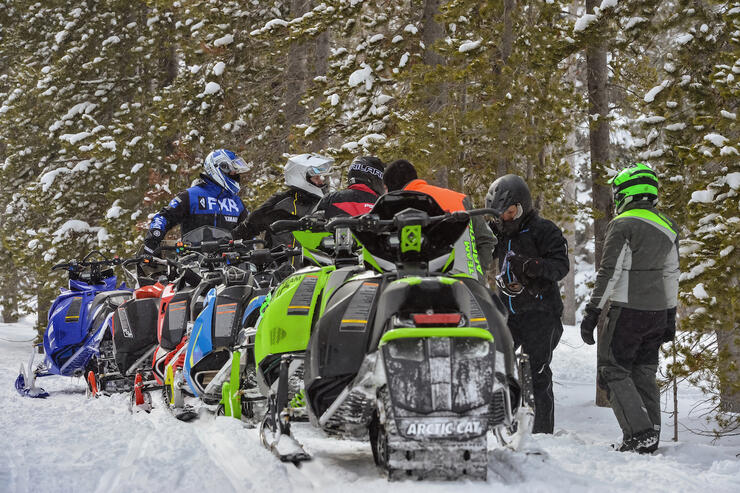
So there you have it, my first Trail Rider’s Glossary of Ontario Snowmobile Jargon. Please message me with any additions you think of and note that I’m not responsible for any alienation from the non-snowmobiling folks in your life that may occur after you start speaking like this all the time!
Ontario law requires a snowmobile entering an OFSC Prescribed Snowmobile Trail to display a valid Ontario Snowmobile Trail Permit.
Recommended Articles
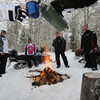
The Complete List of Snowmobile Events in Ontario 2025-2026

The Best Snowmobile-Friendly Lodges
Snowmobiling Winter Weather Forecast 2025-2026

I Rode the Explorers Snow Tour in Ontario and Here’s What It Was Like
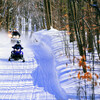
Why Ontario is One of the Best Snowmobile Destinations in the World
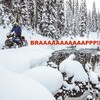
11 TikToks That Prove Ontario is the Best Place To Go Snowmobiling

5 Weekend Snowmobile Getaways Near the GTA
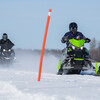
31 Ways To Get In The Know About Snowmobile Trail Riding in Ontario

